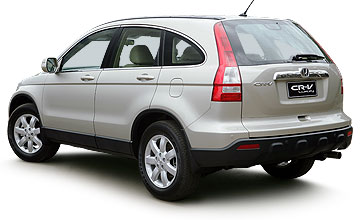BY BYRON MATHIOUDAKIS | 2nd Feb 2007

With the second-generation model released in late 2001, Honda succeeded in addressing the original’s noise, vibration and harshness issues, but then clothed the car in an outfit and interior that were daggier than a Barry Manilow fan-club convention.
Little wonder, then, that CR-V product manager Mitsuru Horikoshi strove to create a car which owners could valet park at a swish hotel without fear of embarrassment or disapproval.
So what we have here now is a new CR-V with a profile that, for some onlookers, recalls an Audi Q7’s, a rear that is reminiscent of a BMW to others… and a nose with an oddball goofy grin.
As that Barry Manilow song goes, “Can’t Smile Without You….”
Happily, from behind the steering wheel, perched in pleasantly spacious, comfortable and – yes – fairly hushed surrounds (save for occasional road noise from certain types of bitumen), you cannot see the CR-V’s front, but now you can see out back better thanks to a spare wheel that’s been removed from the now-single piece and lift-up tailgate for improved rear visibility and weight distribution.
However, we can’t help thinking that Honda could have gone the whole hog and offered a reversing camera.
Nevertheless, visually and functionally, the dashboard is a far-more harmonious effort, bringing to the CR-V hitherto unknown levels of material quality and classy symmetrical design.
At last Honda has banished the hackneyed utilitarian-cabin look that most Asian carmakers still think looks cool on an SUV, but hasn’t actually been hip since Clear Coke was in.
Drivers of any size will appreciate a wheel that now tilts and slides, along with a gear lever that’s handily placed and easily manipulated.
Gone is the annoying dash lever handbrake that so blighted the old model, giving way to an interesting console-mounted T-bar shifter on manual cars, although a stupid foot-operated pedal has been introduced on automatic versions. Mr Horikoshi says an electronic device was rejected on cost grounds.
A CR-V engineer since the first model was unveiled in Japan nearly a dozen years ago, Mr Horikoshi says he was more interested in devising a compact SUV that drove like a sedan, and so the capable Accord Euro was one of the benchmarks.
By an large, Honda has been successful too, thanks to a well-judged handling/ride compromise, lower centre of gravity (the shorter height and repositioned spare wheel help here) and retention of hydraulic power steering that – though a tad slow-reacting and light for keen drivers – delivers better weight and feel than most Japanese 4WDs.
Still a dedicated understeerer through corners, the latest CR-V nevertheless grips gamely, leans a lot less than you might imagine, and turns in with surprising eagerness, again relatively speaking.
Keep in mind though that the engineers responsible for the Mazda CX-7 – let alone the Ford Territory or BMW X3 – won’t lose too much sleep worrying whether Honda has pushed out the dynamic envelope.
The carryover 2.4-litre four-cylinder petrol engine, now slightly more powerful at 125kW, and with a broader spread of torque than before, provides sufficient rather than scintillating performance. Uphill or overtaking manoeuvres do require some careful forethought, since the smooth-revving engine needs to scale the rev range for the necessary power reserves.
In our sub-500km test car, the five-speed automatic proved adequately slick and quite responsive, but we missed having a sequential-shift facility that would have probably have been ideally matched to the peaky nature of the Honda powerplant.
Meanwhile, the new six-speed manual gearbox turned out to be a delight, with its short and precise shift movements, good spread of ratios, and increased interactivity with the mechanical bits for the driver.
Strangely, in the automatic CR-V Luxury, we averaged 10.2L/100km over a 200km rural route, while 11.2L/100km is all that the manual base model could muster over similar roads, despite its 50kg weight advantage.
Still, we believe that Honda is right in predicting that more than half of all CR-V buyers will settle for the base model.
It has everything that a compact SUV buyer could need – four airbags, anti-lock brakes and, commendably, stability control – in a neatly presented and well-specified package.
Conversely, the Sport and Luxury variants also seem and feel far more upmarket than the previous CR-V, so those buyers wanting their 4WD wagon to convey a greater sense of salubriousness than – say – a Subaru Forester or Nissan X-Trail have probably found their ideal set of wheels.
Unavailable Bluetooth connectivity and satellite navigation means that Honda is giving the top-line RAV4 Cruiser L a free kick, however.
For most buyers, this doesn’t matter.
In a savagely competitive segment, with competition as strong as the RAV4, latest Mitsubishi Outlander and new CX-7, Honda seems to have done its homework by righting many of the outgoing CR-V’s wrongs.
If it is a well-rounded, nicely prepared and affordable compact SUV that you need, the third-generation CR-V needs to be at or near the top of your test-drive list.